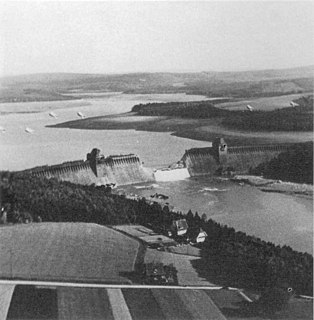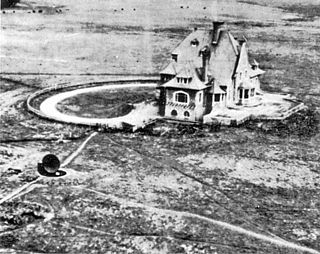
A bomber is a military combat aircraft designed to attack ground and naval targets by dropping air-to-ground weaponry, launching torpedoes, or deploying air-launched cruise missiles. The first use of bombs dropped from an aircraft occurred in the Italo-Turkish War, with the first major deployments coming in the First World War and Second World War by all major airforces causing devastating damage to cities, towns, and rural areas. The first purpose built bombers were the Italian Caproni Ca 30 and British Bristol T.B.8, both of 1913. Some bombers were decorated with nose art or victory markings.

The Luftwaffe was the aerial-warfare branch of the German Wehrmacht before and during World War II. Germany's military air arms during World War I, the Luftstreitkräfte of the Imperial Army and the Marine-Fliegerabteilung of the Imperial Navy, had been disbanded in May 1920 in accordance with the terms of the 1919 Treaty of Versailles which banned Germany from having any air force.

The Battle of Britain, also known as the Air Battle for England, was a military campaign of the Second World War, in which the Royal Air Force (RAF) and the Fleet Air Arm (FAA) of the Royal Navy defended the United Kingdom (UK) against large-scale attacks by Nazi Germany's air force, the Luftwaffe. It has been described as the first major military campaign fought entirely by air forces. The British officially recognise the battle's duration as being from 10 July until 31 October 1940, which overlaps the period of large-scale night attacks known as the Blitz, that lasted from 7 September 1940 to 11 May 1941. German historians do not accept this subdivision and regard the battle as a single campaign lasting from July 1940 to May 1941, including the Blitz.

Operation Chastise was an attack on German dams carried out on the night of 16/17 May 1943 by 617 Squadron RAF Bomber Command, later called the Dam Busters, using special "bouncing bombs" developed by Barnes Wallis. The Möhne and Edersee dams were breached, causing catastrophic flooding of the Ruhr valley and of villages in the Eder valley; the Sorpe Dam sustained only minor damage. Two hydroelectric power stations were destroyed and several more damaged. Factories and mines were also damaged and destroyed. An estimated 1,600 civilians – about 600 Germans and 1,000 forced labourers, mainly Soviet – were killed by the flooding. Despite rapid repairs by the Germans, production did not return to normal until September. The RAF lost 53 aircrew killed and 3 captured, with 8 aircraft destroyed.

Operation Jubilee or the Dieppe Raid was an Allied amphibious attack on the German-occupied port of Dieppe in northern France, during the Second World War. Over 6,050 infantry, predominantly Canadian, supported by a regiment of tanks, were put ashore from a naval force operating under protection of Royal Air Force (RAF) fighters.
The Commando Order was issued by the OKW, the high command of the German armed forces, on 18 October 1942. This order stated that all Allied commandos encountered in Europe and Africa should be killed immediately without trial, even if in proper uniforms or if they attempted to surrender. Any commando or small group of commandos or a similar unit, agents, and saboteurs not in proper uniforms who fell into the hands of the German forces by some means other than direct combat, were to be handed over immediately to the Sicherheitsdienst for execution.

Operation Archery, also known as the Måløy Raid, was a British Combined Operations raid during World War II against German positions on the island of Vågsøy, Norway, on 27 December 1941.

Operation Biting, also known as the Bruneval Raid, was a British Combined Operations raid on a German coastal radar installation at Bruneval in northern France during the Second World War, on the night of 27–28 February 1942.

Operation Agreement was a ground and amphibious operation carried out by British, Rhodesian and New Zealand forces on Axis-held Tobruk from 13 to 14 September 1942, during the Second World War. A Special Interrogation Group party, fluent in German, took part in missions behind enemy lines. Diversionary actions extended to Benghazi, Jalo oasis and Barce. The Tobruk raid was an Allied disaster; the British lost several hundred men killed and captured, one cruiser, two destroyers, six motor torpedo boats and dozens of small amphibious craft.
This is a list of aviation-related events from 1944:

James Allen Ward VC was a New Zealand recipient of the Victoria Cross (VC), the highest and most prestigious award for gallantry "in the face of the enemy" that could be awarded at the time to personnel of the British and Commonwealth forces.

No. 487 (NZ) Squadron was a Royal New Zealand Air Force light-bomber squadron, formed under Article XV of the Empire Air Training Scheme during World War II. Established in mid-1942, the squadron served in the European theatre, under the operational command of the Royal Air Force. It operated the Lockheed Ventura and de Havilland Mosquito and took part in over 3,000 operational sorties before being disbanded at the end of the war in late 1945.
Melitta Schenk Gräfin von Stauffenberg was an aviator who served as a test pilot in the Luftwaffe before and during World War II.

Target for Tonight is a 1941 British World War II documentary film billed as filmed and acted by the Royal Air Force, all during wartime operations. It was directed by Harry Watt for the Crown Film Unit. The film is about the crew of a Wellington bomber taking part in a bombing mission over Nazi Germany. The film won an honorary Academy Award in 1942 as Best Documentary by the National Board of Review. Despite purporting to be a documentary there are multiple indicators that it is not quite as such: film shots include studio shots taken from the exterior of the aircraft looking into the cockpit whilst "in flight"; several stilted sections of dialogue are clearly scripted; on the ground shots of bombing are done using model trains; and several actors appear. The film does give a unique insight into the confined nature of the Wellington's interior and some of the nuances of day to day operation such as ground crew holding a blanket over the engine while it starts to regulate oxygen intake.
Patrick Palles Lorne Elphinstone Welch,, known as Lorne Welch, was a British engineer, pilot and Colditz prisoner of war.
Stalag Luft I was a German World War II prisoner-of-war (POW) camp near Barth, Western Pomerania, Germany, for captured Allied airmen. The presence of the prison camp is said to have shielded the town of Barth from Allied bombing. About 9,000 airmen – 7,588 American and 1,351 British and Canadian – were imprisoned there when it was liberated on the night of 30 April 1945 by Russian troops.

Strategic bombing during World War I was principally carried out by the United Kingdom and France for the Entente Powers and Germany for the Central Powers. All the belligerents of World War I eventually engaged in strategic bombing, and, with the exception only of Rome and Lisbon, the capital cities of all the major European belligerents were targeted. A multi-national air force to strike at Germany was planned but never materialized. The aerial bombing of cities, intended to destroy the enemy's morale, was introduced by the Germans in the opening days of the war.

Operation Gisela was the codename for a German military operation of the Second World War. Gisela was designed as an aerial intruder operation to support the German air defence system in its night battles with RAF Bomber Command during the Defence of the Reich campaign. It was the last major operation launched by the Luftwaffe Nachtjagdgeschwader during the conflict.
Simon Bovey, is a British scriptwriter and director. He has written several science fiction dramas for BBC Radio, as well as episodes of the daytime drama Doctors.

The Raid on Sidi Haneish Airfield was a military operation carried out the night of 26 July 1942. A British Special Air Service unit commanded by Major David Stirling attacked a German-held airfield in Egypt during the Western Desert Campaign of Second World War. Several Luftwaffe aircraft used to ferry supplies to the Axis forces were destroyed or damaged with machine-gun fire and explosives. Axis front line units were diverted to reinforce the garrisons in the rear vulnerable to attack.













